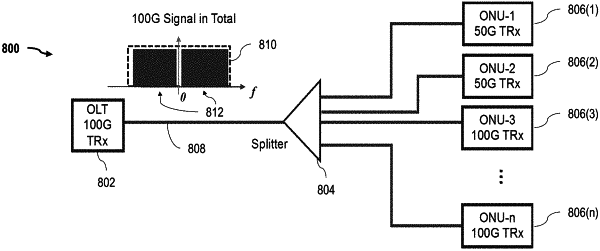| CPC H04J 14/0282 (2013.01) [H04J 14/025 (2013.01); H04J 14/0246 (2013.01); H04J 14/0247 (2013.01)] | 20 Claims |

|
1. A passive optical network (PON), comprising:
a downstream transceiver including (i) a downstream processor configured to map a downstream data stream to a plurality of sub-bands of a frequency spectrum, and (ii) a downstream transmitter configured to transmit a downstream optical signal modulated with the plurality of sub-bands;
an optical transport medium in operable communication with the downstream transceiver, and configured for carrying the downstream and upstream optical signals;
a first upstream transceiver in operable communication with the optical transport medium, and including (i) a first local oscillator (LO) configured to tune a first LO center frequency to a first sub-band of the plurality of sub-bands, and (ii) a first downstream receiver configured for coherent detection of the downstream optical signal within the first sub-band; and
a second upstream transceiver in operable communication with the optical transport medium, and including (i) a second LO having a second LO center frequency, and (ii) a second downstream receiver configured for coherent detection of the downstream optical signal within a second sub-band of the plurality of sub-bands,
wherein the downstream processor is further configured to (i) dynamically allocate the first and second sub-bands to the first and second transceivers in both of the time and frequency domains, (ii) allocate the first sub-band to the first transceiver at a first time utilizing a first channel, (iii) allocate the second sub-band to the second transceiver at a second time utilizing a second channel, and (iv) allocate the first sub-band to the first transceiver at a third time utilizing a third channel different from the first channel, and
wherein the first time is different from the third time.
|